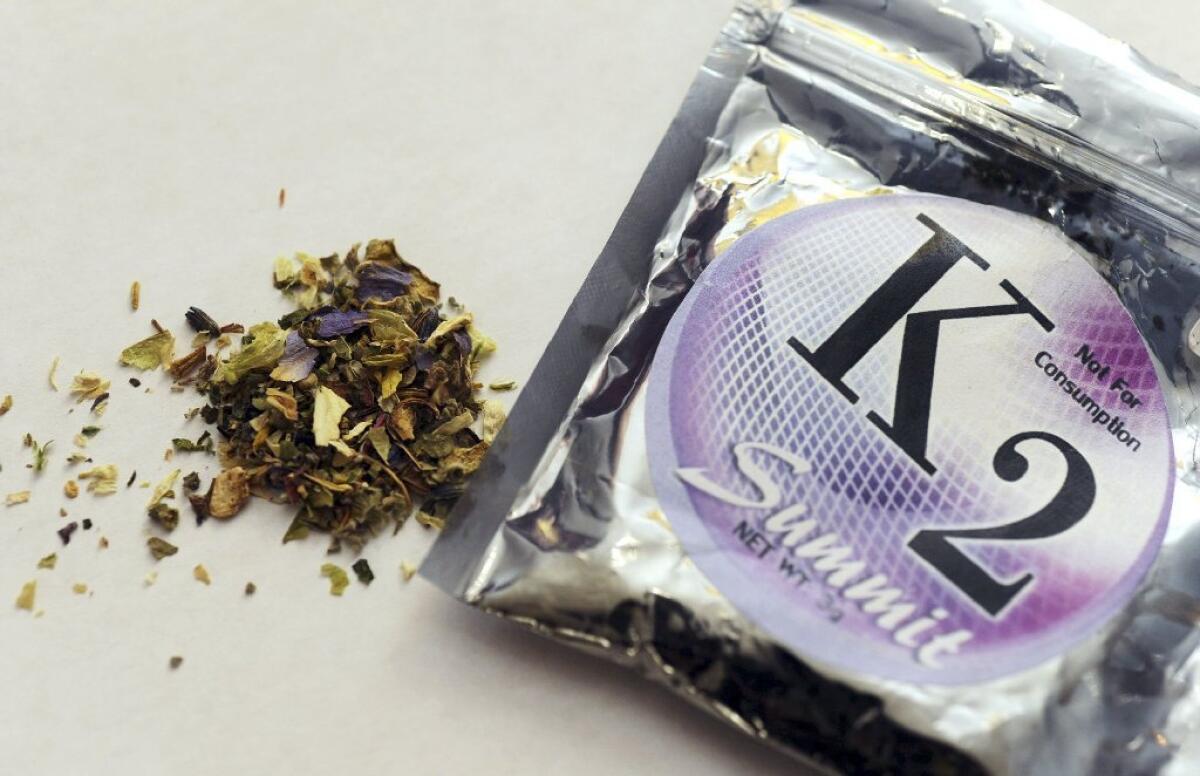Increase in poisoning reveals dangers of ‘synthetic marijuana,’ CDC says

This package of K2 contains herbs and spices sprayed with a synthetic compound chemically similar to THC, the psychoactive ingredient in marijuana. A new report highlights a 330% increase in reported poisonings from synthetic cannabinoids over the first four months of 2015.
- Share via
Synthetic cannabinoids have been marketed as safe, legal, herbal alternatives to marijuana, but the data from U.S. poison control centers say otherwise. Poison center calls linked to synthetic cannabinoids have spiked roughly fourfold in just the first few months of 2015, according to a report from the Centers for Disease Control and Prevention.
The sudden rise shows that tighter regulation of such substances is sorely needed, according to the authors of the CDC report.
“Multiple other recent outbreaks suggest a need for greater public health surveillance and awareness, targeted public health messaging, and enhanced efforts to remove these products from the market,” the researchers led by CDC epidemiologist Royal Law wrote in the center’s Morbidity and Mortality Weekly Report.
Synthetic cannabinoids (whose aliases include synthetic marijuana, spice, K2, black mamba and crazy clown) are made by spraying synthetic psychoactive chemicals onto plant matter, which can then be smoked or consumed.
Because the producers of the psychoactive chemicals can continually tweak their formulas, it can be hard for government regulators to keep up.
“Manufacturers of Spice products attempt to evade these legal restrictions by substituting different chemicals in their mixtures,” according to the National Institute on Drug Abuse.
The researchers analyzed the numbers from the National Poison Data System, which tracks the monthly calls to all U.S. poison centers. The number of calls in April had shot up to 1,501– a whopping 330% over the 349 calls made in January.
Between January and May 2015, poison centers received 3,572 calls linked to synthetic cannabinoid use – a 229% jump over the 1,085 calls received during the same period in 2014.
A total of 626 calls reported that the synthetic cannabinoids had been used with multiple substances; the top two were alcohol (144) and plant-based marijuana (103).
The median age of the user was 26, but the ages spanned a range of 7 months to 72 years. (Presumably, someone else called on behalf of the 7-month-old.) Negative effects seemed to hit older users harder; those in their 30s and over 40 were more likely than those ages 10 to 19 to suffer “severe” outcomes, the authors wrote.
Among the commonly reported health effects: agitation (1,262), rapid heart rate (1,035) and vomiting (585). And for the 2,961 with a reported medical outcome, 335 (11.3%) suffered either highly dangerous or potentially deadly effects; 15 deaths were reported (up from five during the same period in 2014). Only one of the deaths during the first five months of 2015 appeared to involve multiple-substance abuse.
“The increasing number of synthetic cannabinoid variants available, higher toxicity of new variants, and the potentially increased use as indicated by calls to poison centers might suggest that synthetic cannabinoids pose an emerging public health threat,” the study authors wrote.
Follow @aminawrite for more safe, legal and occasionally herbal science news.







